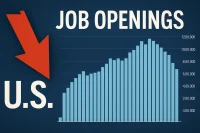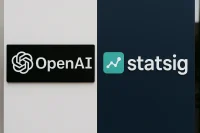The Unprecedented Stagnation in Today’s Job Market
The job market has reached an unprecedented state of stagnation that has left millions of workers feeling trapped and uncertain about their professional futures. This frozen job market phenomenon represents a fundamental shift from the dynamic employment landscape that characterized previous decades, creating a perfect storm of factors that have essentially paralyzed career mobility for countless professionals.
The data paints a clear picture of this stagnation. Companies are not hiring at historical rates, yet they are also not terminating employees in the same aggressive manner that characterized previous economic downturns. This creates a unique situation where workers find themselves in a state of professional limbo—unable to advance in their current roles while simultaneously unable to find better opportunities elsewhere.
Understanding the Job Hugging Phenomenon
The latest employment trend, aptly termed “job hugging,” perfectly encapsulates the current state of the workforce. Workers are hanging onto their current positions for dear life, not because they are satisfied with their roles, but because the alternative—entering the job market—appears far more daunting and uncertain.
This job hugging behavior stems from a perfect storm of economic factors that have fundamentally altered how both employers and employees approach career decisions. The traditional career progression model, where workers could reasonably expect to move between companies every few years for better opportunities, has been completely disrupted by a combination of economic uncertainty, technological disruption, and shifting corporate priorities.
Want to Reach Committed Talent?
In today’s era of “job hugging,” candidates are prioritizing stability. Post your jobs on WhatJobs and connect with workers ready to stay and grow with your company.
👉 Post a Job Now →The Data Behind the Frozen Job Market
Recent employment data reveals the true extent of this market stagnation. Initial unemployment claims, which serve as a key indicator of layoff activity, have returned to pre-pandemic levels, hovering around 220,000 to 250,000 per week. While this might seem like good news on the surface, it actually represents a return to a baseline that was already characterized by limited job security and frequent layoffs.
Job postings tell an even more concerning story. After reaching a peak of 160% above baseline levels in May 2022, job postings have steadily declined to just 5% above historical averages. However, this modest increase in postings masks a more troubling reality: many of these positions have been transformed into fractional, part-time, or non-benefits-eligible roles that offer significantly less security and compensation than traditional full-time positions.
The Fractionalization of Work
One of the most significant trends contributing to the frozen job market is the systematic fractionalization of traditional employment. Companies have increasingly taken full-time positions and broken them down into multiple smaller, part-time, or contract roles that offer reduced benefits, lower compensation, and significantly less job security.
This fractionalization represents a fundamental shift in how corporations approach workforce management. Rather than investing in long-term employee relationships, companies are treating labor as a commodity to be optimized for cost efficiency rather than human development. The result is a workforce that feels increasingly disposable and uncertain about their professional futures.
The impact of this trend extends far beyond individual job security. It has created a ripple effect throughout the entire economy, as workers with reduced incomes and benefits have less purchasing power, leading to decreased consumer confidence and economic growth. This creates a self-reinforcing cycle where economic uncertainty leads to more conservative hiring practices, which in turn further depresses economic activity.
The Middle Management Crisis
Another critical factor contributing to the frozen job market is the systematic elimination of middle management positions. Companies have engaged in what can only be described as a “war on the middle manager,” decimating entire layers of management that once provided crucial career advancement opportunities for experienced workers.
This elimination has created a massive gap in organizational structure, leaving experienced workers without clear paths for advancement while simultaneously burdening senior management with responsibilities that were previously distributed across multiple levels. The result is a workforce that feels trapped in their current positions with no clear path forward, regardless of their experience or qualifications.
The psychological impact of this structural change cannot be overstated. Workers who have spent years developing their skills and building their careers suddenly find themselves in a professional landscape where the traditional career ladder has been dismantled, leaving them with no clear way to advance or improve their circumstances.
Bridging the Leadership Gap?
With middle management roles shrinking, strong leadership is in higher demand than ever. Post your jobs on WhatJobs to reach skilled professionals ready to step up.
👉 Post a Job Now →The Path Forward: Reclaiming Control in a Frozen Market
Despite the challenging nature of the current job market, there are strategies that can help workers navigate this frozen landscape and reclaim control over their professional destinies. The key lies in understanding that the traditional rules of career advancement no longer apply and adapting accordingly.
The most successful professionals in today’s market are those who have learned to operate independently of traditional corporate structures. They have developed multiple income streams, built strong professional networks, and positioned themselves as valuable assets that companies actively seek out rather than passive job seekers competing for limited opportunities.
This approach requires a fundamental shift in mindset from being an employee to being a professional service provider. Instead of waiting for opportunities to be created by employers, successful professionals create their own opportunities by identifying market needs and positioning themselves to fill those needs.
The Role of Technology and AI in Market Stagnation
The rapid advancement of artificial intelligence and automation technologies has added another layer of complexity to the frozen job market. While these technologies have the potential to create new opportunities, they are also displacing traditional roles at an unprecedented rate, further contributing to the sense of uncertainty and stagnation that characterizes the current employment landscape.
The challenge for workers is not just competing with other humans for limited opportunities, but also competing with increasingly sophisticated AI systems that can perform many tasks that were previously the exclusive domain of human workers. This technological disruption has created a sense of urgency among workers to develop new skills while simultaneously making it more difficult to find stable employment in which to develop those skills.
Frequently Asked Questions
What is the frozen job market and why is it happening?
The frozen job market refers to the current state of employment where workers are stuck in their positions due to a combination of factors including reduced hiring activity, increased job insecurity, and the elimination of traditional career advancement opportunities. It’s happening because companies have become more conservative in their hiring practices while simultaneously restructuring their workforces to be more cost-effective.
How long will the frozen job market last?
While it’s difficult to predict exactly how long the current market stagnation will persist, the underlying factors that created this situation—including technological disruption, economic uncertainty, and structural changes in how companies approach workforce management—suggest that this may be a long-term shift rather than a temporary downturn.
What can workers do to navigate the frozen job market?
Workers can navigate the frozen job market by developing multiple income streams, building strong professional networks, positioning themselves as valuable service providers rather than traditional employees, and focusing on developing skills that are in high demand and difficult to automate.
Is the frozen job market affecting all industries equally?
No, the frozen job market is affecting different industries to varying degrees. Some sectors, particularly those that can be easily automated or outsourced, are experiencing more significant challenges, while others that require human creativity, emotional intelligence, or specialized expertise may be more resilient.
A Real-World Example: Sarah’s Journey Through the Frozen Market
Sarah, a marketing manager with eight years of experience, found herself trapped in the frozen job market after her company eliminated her department during a restructuring. Despite having a strong resume and excellent references, she spent six months applying to hundreds of positions without receiving a single interview request.
Frustrated by the traditional job search process, Sarah decided to take a different approach. She began offering her marketing services as a consultant to small businesses in her area, leveraging her expertise to help them develop their online presence and marketing strategies. Within three months, she had built a client base that provided her with more income than her previous salary, along with the flexibility and control over her work that she had never experienced as an employee.
Sarah’s story illustrates how the frozen job market, while challenging, can also serve as a catalyst for professional reinvention. By stepping outside the traditional employment model and positioning herself as a service provider rather than a job seeker, she was able to create opportunities that didn’t exist in the conventional job market.
The frozen job market represents a fundamental shift in how we think about work and career advancement. While it presents significant challenges, it also offers opportunities for those willing to adapt and think creatively about their professional futures. The key is recognizing that the old rules no longer apply and being willing to write new ones that work in today’s economic reality.




